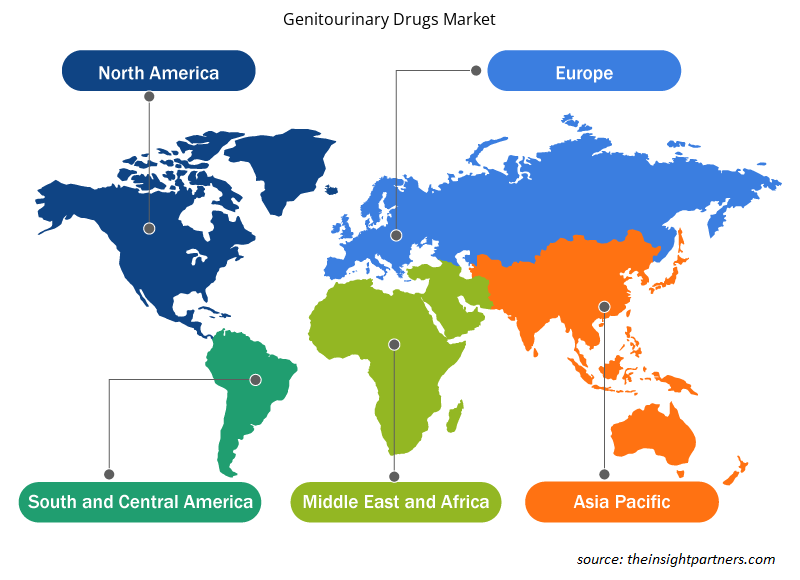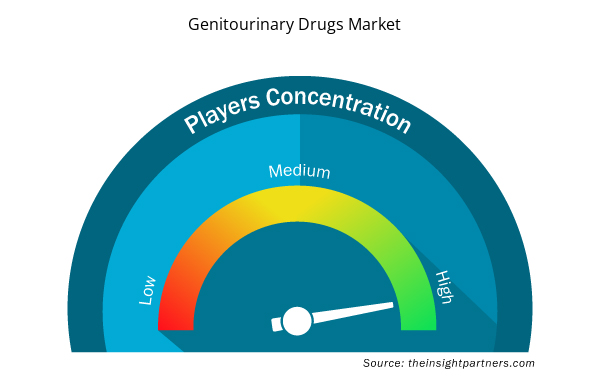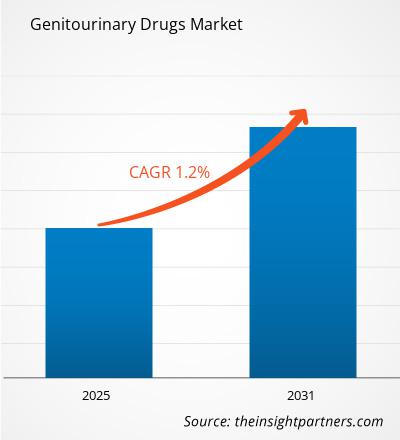The Genitourinary Drugs Market is expected to register a CAGR of 1.2% from 2025 to 2031, with a market size expanding from US$ XX Million in 2024 to US$ XX Million by 2031.
The research report on the genitourinary drugs market is categorized by product type into hormonal therapy, anti-infective drugs, and others. Applications include urinary tract infections, bladder disorders, prostate cancer, and others. End-users include hospitals, clinics, and retail pharmacies. The regional analysis covers key markets such as North America, Europe, Asia Pacific, the Middle East and Africa, and South America. The market valuation is provided in US$ for all segmental analyses.
Purpose of the Report
The report Genitourinary Drugs Market by The Insight Partners aims to describe the present landscape and future growth, top driving factors, challenges, and opportunities. This will provide insights to various business stakeholders, such as:
- Technology Providers/Manufacturers: To understand the evolving market dynamics and know the potential growth opportunities, enabling them to make informed strategic decisions.
- Investors: To conduct a comprehensive trend analysis regarding the market growth rate, market financial projections, and opportunities that exist across the value chain.
- Regulatory bodies: To regulate policies and police activities in the market with the aim of minimizing abuse, preserving investor trust and confidence, and upholding the integrity and stability of the market.
Genitourinary Drugs Market Segmentation
Disease
- Genitourinary Cancer
- Bladder Cancer
- Cervical Cancer
- Kidney/Renal Cancer
- Ovarian Cancer
- Prostate Cancer
Product
- Sex Hormones
- Urologic
- Genitourinary Anti-Infective
- Gynecological
Customize This Report To Suit Your Requirement
You will get customization on any report - free of charge - including parts of this report, or country-level analysis, Excel Data pack, as well as avail great offers and discounts for start-ups & universities
Genitourinary Drugs Market: Strategic Insights

- Get Top Key Market Trends of this report.This FREE sample will include data analysis, ranging from market trends to estimates and forecasts.
Genitourinary Drugs Market Growth Drivers
- Increased Prevalence of Genitourinary Disorders: The two main drivers for the market are the raising global prevalence of genitourinary disorders, which are on an upward trend. UTIs, BPH, OAB, and sexual dysfunction are become increasingly more widespread throughout the world with growing populations of aging people, poor lifestyle habits and increasing rates of chronic conditions like diabetes. According to the National Institute of Diabetes and Digestive and Kidney Diseases (NIDDK), nearly 50% of men over the age of 50 experience symptoms related to BPH, while urinary tract infections are among the most common bacterial infections worldwide. Additionally, conditions such as erectile dysfunction (ED) and female sexual dysfunction are also on the rise, particularly in older adults. With an increase in the prevalence of these disorders, the genitourinary drugs market is expanding as more people are seeking pharmaceuticals for the treatment of these disorders.
- Demographic Trends: The growth in the genitourinary drugs market is significantly influenced by the aging population across the globe. As the global population ages, they are likely to develop genitourinary disorders, especially conditions like urinary incontinence, prostate cancer, and erectile dysfunction. The WHO projects that the population aged 60 years and older will have increased to 2.1 billion by 2050, while in 2020, it had already reached 1 billion. With the rising elderly population, the need for genitourinary disease-specific treatments is bound to rise. Moreover, elderly patients generally have comorbidities such as diabetes and cardiovascular diseases that can worsen the conditions of genitourinary diseases, thus demanding more specific therapeutic interventions.
- Advances in Drug Development: Advances in pharmaceutical research and drug development are assisting in addressing unmet medical needs in the genitourinary space. The emergence of new classes of drugs, such as selective serotonin and norepinephrine reuptake inhibitors (SNRIs) for the treatment of overactive bladder, and the development of newer formulations of drugs for prostate cancer and erectile dysfunction, are improving patient outcomes. Advances in biologics and immunotherapies further assist in handling prostate cancer, bladder cancer, and more. For instance, with respect to bladder cancer, an immune checkpoint inhibitor in the name of pembrolizumab or Keytruda was approved which, for the first time, offered patients another possibility beyond chemotherapy. Thus, ongoing developments in this drug pipeline for genitourinary conditions will also advance the market.
Genitourinary Drugs Market Future Trends
- Shift Toward Non-invasive and Oral Medications: There is a growing trend toward non-invasive treatments, particularly oral medications, for managing genitourinary conditions. Patients prefer oral medications due to their ease of use and convenience compared to injectable or invasive treatments. This trend is evident in the increasing popularity of oral drugs for conditions like erectile dysfunction, BPH, and overactive bladder. For instance, the drugs tadalafil (Cialis) and sildenafil (Viagra), which have become mainstays of treatment for erectile dysfunction, gained acceptance because they were not invasive. Similarly, oral drugs like solifenacin and tolterodine used in OAB have gained acceptance instead of invasive therapies like botulinum toxin injections. The shift towards oral medications reflects a broader movement in healthcare towards more patient-friendly treatment options, which is likely to continue influencing the genitourinary drugs market.
- Personalized Medicine and Targeted Therapies: Personalized medicine and targeted therapies are becoming more prevalent in the genitourinary drugs market. Advances in molecular biology and genomics have enlightened the genetic and molecular underpinning of disorders in the genitourinary system, especially cancers of the prostate and bladder. In this regard, the emergence of enzalutamide (Xtandi) and abiraterone (Zytiga) as targeted therapies for metastatic castration-resistant prostate cancer reflects the shift towards individualized treatments that more specifically target malignant cells with lesser damage to the normal tissue. Genetic testing and biomarkers are increasingly used to customize the treatment plans for patients with genitourinary cancers and other conditions. Personalized medicine not only improves the outcomes of treatment but also reduces the chance of adverse side effects, thus being one of the major trends in the market.
- Another one is Increased Concentration on the Health of the Female: an emerging trend by the genitourinary drug industry. Attention concerning urinary incontinence, prolapse of female pelvic organs and female sexual function condition increase. The examples include incontinence where such condition has struck about 25% of global women and majority of these happens upon getting birthed. The treatment gap is being bridged by having drugs such as Mirabegron for overactive bladder. In addition, hormone replacement therapies (HRT) and non-hormonal treatments of vaginal atrophy with sexual dysfunction are experiencing an increase in popularity due to an aging female population. As women's genitourinary health is now given more attention, coupled with an increased awareness of these conditions, a growing market opportunity exists for drug developers to innovate and produce drugs that can better respond to women's needs.
Genitourinary Drugs Market Opportunities
- Advancements in Prostate Cancer Therapies: Prostate cancer is one of the most common cancers in men, especially in older populations. The emergence of new therapies for prostate cancer is a significant opportunity in the genitourinary drugs market. Immunotherapy and targeted therapies are changing the prostate cancer treatment landscape. An example includes drugs like abiraterone acetate and enzalutamide, targeting androgen receptors, that significantly have improved survival for patients with metastatic prostate cancer. There is also a host of emerging therapies for advanced or resistant prostate cancer. CAR-T cell therapy and immune checkpoint inhibitors. With an ever-increasing global incidence of prostate cancer, the pharmaceutical industry will find opportunities in newer and more effective treatments.
- Market Opportunities due to Growing Prevalence of Erectile Dysfunction: The rise in erectile dysfunction cases is presenting massive market opportunities for drugs targeting the condition. ED is a leading problem, affecting up to 30 million men in the United States alone, often linked to comorbidities like diabetes, hypertension, and cardiovascular diseases. The global market for erectile dysfunction drugs is therefore anticipated to grow as the population of aging men with chronic conditions rises. More so, the increasing recognition and acceptance of treatments for ED, oral drugs such as sildenafil (Viagra), tadalafil (Cialis), and newer formulations, avanafil (Stendra) are driving growth in the market. As further research and development into more potent and longer-acting treatments continue to be developed, the demand for ED drugs is going to increase further, opening new avenues for the pharmaceutical companies in terms of expanded product lines.
- Market expansion: Additionally, improvements in healthcare infrastructure and rising income levels are leading to increased access to medications for conditions such as urinary tract infections, erectile dysfunction, and prostate disorders. According to a report by the World Bank, healthcare expenditure in emerging economies is expected to grow by 5.3% annually, leading to increased demand for pharmaceuticals in these regions. Companies that can navigate regulatory challenges and establish a strong presence in these markets stand to benefit from the rising demand for genitourinary treatments.
Genitourinary Drugs Market Regional Insights
The regional trends and factors influencing the Genitourinary Drugs Market throughout the forecast period have been thoroughly explained by the analysts at Insight Partners. This section also discusses Genitourinary Drugs Market segments and geography across North America, Europe, Asia Pacific, Middle East and Africa, and South and Central America.

- Get the Regional Specific Data for Genitourinary Drugs Market
Genitourinary Drugs Market Report Scope
| Report Attribute | Details |
|---|---|
| Market size in 2024 | US$ XX Million |
| Market Size by 2031 | US$ XX Million |
| Global CAGR (2025 - 2031) | 1.2% |
| Historical Data | 2021-2023 |
| Forecast period | 2025-2031 |
| Segments Covered |
By Disease
|
| Regions and Countries Covered | North America
|
| Market leaders and key company profiles |
Genitourinary Drugs Market Players Density: Understanding Its Impact on Business Dynamics
The Genitourinary Drugs Market market is growing rapidly, driven by increasing end-user demand due to factors such as evolving consumer preferences, technological advancements, and greater awareness of the product's benefits. As demand rises, businesses are expanding their offerings, innovating to meet consumer needs, and capitalizing on emerging trends, which further fuels market growth.
Market players density refers to the distribution of firms or companies operating within a particular market or industry. It indicates how many competitors (market players) are present in a given market space relative to its size or total market value.
Major Companies operating in the Genitourinary Drugs Market are:
- Astellas
- Betanis
- GlaxoSmithKline
- Bayer AG
- Merck KGaA
- Abbott Laboratories
Disclaimer: The companies listed above are not ranked in any particular order.

- Get the Genitourinary Drugs Market top key players overview
Key Selling Points
- Comprehensive Coverage: The report comprehensively covers the analysis of products, services, types, and end users of the Genitourinary Drugs Market, providing a holistic landscape.
- Expert Analysis: The report is compiled based on the in-depth understanding of industry experts and analysts.
- Up-to-date Information: The report assures business relevance due to its coverage of recent information and data trends.
- Customization Options: This report can be customized to cater to specific client requirements and suit the business strategies aptly.
The research report on the Genitourinary Drugs Market can, therefore, help spearhead the trail of decoding and understanding the industry scenario and growth prospects. Although there can be a few valid concerns, the overall benefits of this report tend to outweigh the disadvantages.
- Historical Analysis (2 Years), Base Year, Forecast (7 Years) with CAGR
- PEST and SWOT Analysis
- Market Size Value / Volume - Global, Regional, Country
- Industry and Competitive Landscape
- Excel Dataset



Report Coverage
Revenue forecast, Company Analysis, Industry landscape, Growth factors, and Trends

Segment Covered
This text is related
to segments covered.

Regional Scope
North America, Europe, Asia Pacific, Middle East & Africa, South & Central America

Country Scope
This text is related
to country scope.
Frequently Asked Questions
The Genitourinary Drugs Market is expected to register a CAGR of 1.2% from 2025-2031.
The major driving factors supporting the Genitourinary Drugs market growth are - Increased Prevalence of Genitourinary Disorders, Demographic Trends, Advances in Drug Development
Key future trends in the Genitourinary Drugs Market are - Shift Toward Non-invasive and Oral Medications, Personalized Medicine and Targeted Therapies, Increased Focus on Female Genitourinary Health
Key companies in the Genitourinary Drugs Market are- , Astellas, Betanis, GlaxoSmithKline, Bayer AG, Merck KGaA, Abbott Laboratories, Merck & Co, Bristol-Myers Squibb Co, Genentech Inc, Hoffman-La Roche Inc
The report can be delivered in PDF/PPT format; we can also share excel dataset based on the request.
Some of the customization options available based on request are additional 3–5 company profiles and country-specific analysis of 3–5 countries of your choice. Customizations are to be requested/discussed before making final order confirmation, as our team would review the same and check the feasibility.
Trends and growth analysis reports related to Life Sciences : READ MORE..
The List of Companies
- Astellas
- Betanis
- GlaxoSmithKline
- Bayer AG
- Merck KGaA
- Abbott Laboratories
- Merck & Co
- Bristol-Myers Squibb Co
- Genentech Inc
- Hoffman-La Roche Inc

 Get Free Sample For
Get Free Sample For